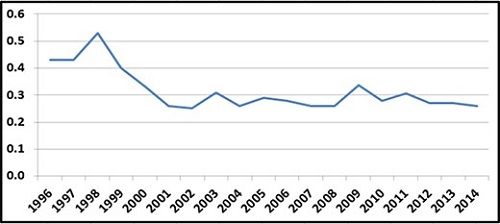Listeria Outbreaks Linked to Ice Cream Show a Little Contamination Goes a Long Way
A team of researchers has found that individuals with weakened immune systems are the most at risk of infection by listeriosis contamination in food products.
Updated: 1/6/2017 at 10:57 AM EST.
Since 2013, there have been at least 10 separate outbreaks of Listeriosis or contamination with Listeria monocytogenes, in the United States. The Centers for Disease Control and Prevention (CDC) defines an outbreak as any instance when two or more people get the same illness from contaminated food or drink; when this happens in more than one state, the outbreak is termed a multistate outbreak. In the case of Listeriosis, the issue has made a number of headlines over the past two years, thanks in large part to the ongoing issues a high-profile ice cream manufacturer experienced with the bacterium in its factories that had resulted in a massive product recall back in 2015. The contaminated ice cream proved to be a unique situation for researchers because ice cream has a long shelf life and the Listeria bacterium survives, but does not grow, while frozen in the product. As a result, scientists and the US Food and Drug Administration (FDA) were able to obtain a relatively large sample of contaminated products and determine that very low dosage levels of Listeria can lead to infection in populations that are already at risk, such as those who are pregnant, the elderly, and the immunocompromised.
A team of researchers from the FDA and Via Christi Hospitals in Wichita, Kansas, worked together to analyze three cases involved in a multistate outbreak of listeriosis that took place in 2013 and 2014 and was linked back to ice cream products in 2015. There were a total of 10 patients involved in the outbreak, and five of them were inpatients of the same Kansas hospital and likely ate the contaminated ice cream products in the form of milkshakes while in the hospital. Of those five, three had food histories that enabled the team to verify their consumption of the ice cream products and the frequency with which they ate them. No patient had more than one milkshake in a given day, and two of the three actually consumed the ice cream products multiple days apart, meaning that the overall dosage consumed by the patients was extremely low.
“A precise quantification of exposure to L. monocytogenes ingestion through contaminated ice cream is difficult to infer,” the team noted, although they added that the assessment of exposures among populations is more feasible. It is likely more practical for medical professionals as well, who can be alert for signs of infection among particularly susceptible populations. It is important to note that in the hospital in question, there had not been any diagnoses among pregnant women. According to the researchers, the real issue at hand for medical professionals is that, “despite the relatively low levels of contamination of ice cream products in this listeriosis outbreak, the exceptionally high prevalence of contaminated products combined with the protracted duration of the production line contributed to the exposure of many individuals [within and outside hospital care].” Likely, the number of infections was actually larger than had been reported because frozen products do not support growth of the bacterium, compared to, for example, another earlier and much larger outbreak—with 147 total cases—that had been linked to cantaloupe, which does support growth and is not stored frozen.
Regis Pouillot, DVM, PhD, the contact for the team, noted that since all of the cases in the study occurred in the same hospital, it was impossible to fully rule out a growth of the bacteria on a milkshake machine or some kind of “systematic issue” that might have increased dosage levels between the time the ice cream left the containers and the time that the milkshakes were consumed. However, the “takeaway” lesson from the study remains that individuals with weakened immune systems are at the most risk of infection by listeriosis contamination in food products and, as a result, there is a need for further development of effective risk management to prevent and mitigate infections.
A CDC spokesperson added that risk management of patients with elevated risk of contracting invasive Listeriosis who may have consumed contaminated food products often must be made “on a case-by-case basis, informed by clinical judgment and the likelihood of exposure of the patient” since many patients present few or no symptoms but consult a physician as a result of consuming a recalled product. However, familiarity with mild symptoms other than diarrhea and fever such as headache, stiff neck, and loss of balance that tend to affect older adults and immunocompromised individuals who may not display other symptoms will aid physicians in making a diagnosis and determining the best treatment moving forward. Patients who develop symptoms within two months of eating the recalled product should return for medical treatment, she added.
Karl C. Klontz, MD, physician and epidemiologist at the FDA, recommended that the medical community continue to educate their patients about making proper food choices, especially for those at highest risk of infection. “The truth is less people are becoming infected rates of listeriosis (that is, number of cases per 100,000 population per year; see chart) have decreased substantially over the past 16 years,” he said. “For that, we can credit sound education and a better oversight of the nation’s food supply.”
Chart: Number of Cases of Listeriosis Per 100,000 Population Per Year

Data Source: FoodNet
